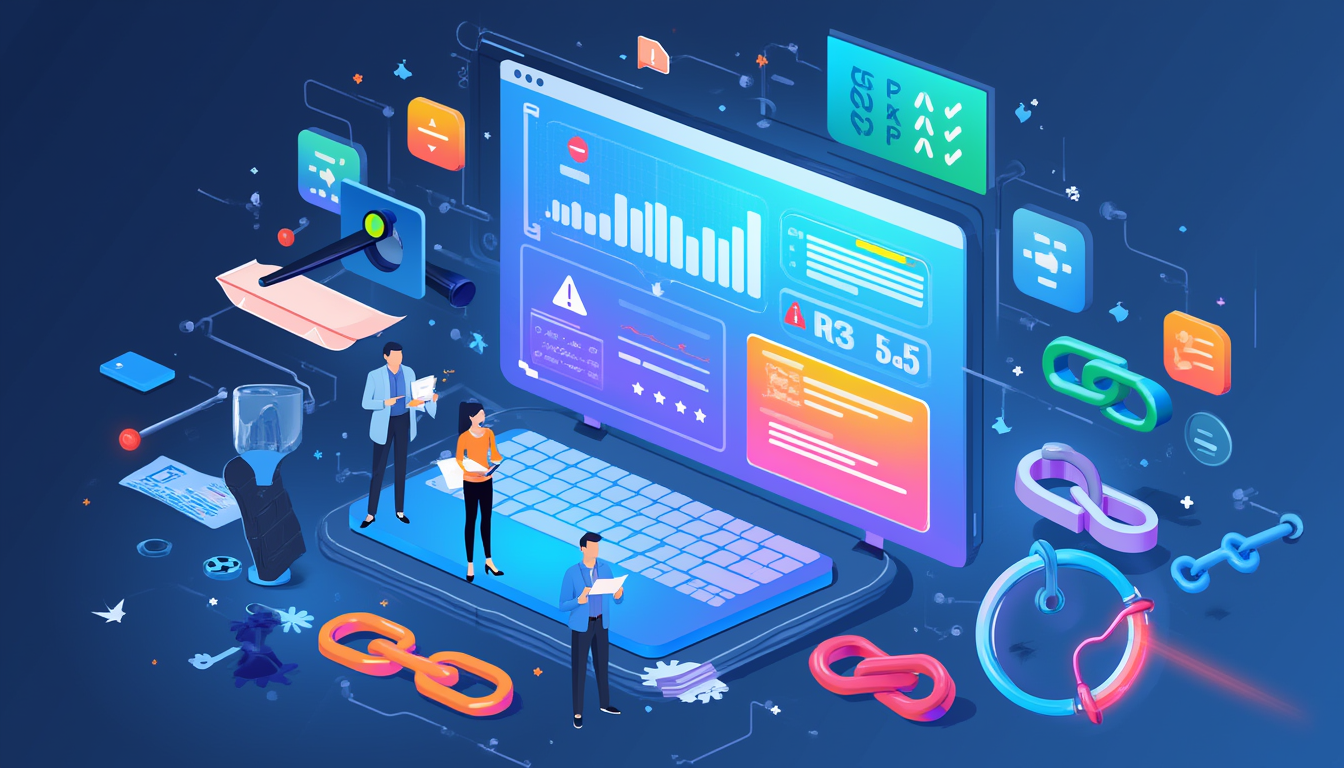Backlink Monitoring Guide: Protect Your SEO Investment
Learn how to monitor backlinks effectively, respond to lost links, and protect your SEO rankings with automated monitoring strategies and best practices.

Picture this: You've spent months building high-quality backlinks to your website. You've reached out to industry publications, created valuable content, and finally secured those coveted links from authoritative domains. Your rankings are climbing, traffic is flowing, and everything looks perfect.
Then, without warning, your rankings tank overnight.
What happened? Those carefully earned backlinks started disappearing—some removed entirely, others changed to nofollow, and a few redirected to broken pages. The worst part? You had no idea it was happening until it was too late.
If this scenario sounds familiar, you're not alone. Studies show that websites lose an average of 5-10% of their backlinks every month, often without the site owner knowing. That's thousands of dollars in SEO investment vanishing into thin air.
Here's the thing: building backlinks is just half the battle. The real challenge is protecting them. In this comprehensive guide, we'll walk you through everything you need to know about backlink monitoring—from understanding why it matters to implementing automated systems that keep your SEO investment safe.
Why Backlink Monitoring Matters More Than You Think
Let's be real about the numbers. The average cost to acquire a high-quality backlink ranges from $100 to $1,500, depending on the domain authority and industry. For a typical business with 500 backlinks, that represents an investment of $50,000 to $750,000 in link building efforts.
Now imagine losing 10% of those links without knowing it. That's potentially $75,000 in SEO value gone—and that's just the direct cost. The indirect costs are even more staggering.
The Hidden Cost of Lost Backlinks
When backlinks disappear, the impact goes far beyond the immediate loss of link equity:
Rankings Drop: Google's algorithm considers backlinks as votes of confidence. When those votes disappear, your rankings can plummet within days or weeks.
Traffic Decline: Lower rankings mean less organic traffic. A drop from position 3 to position 8 can reduce your click-through rate by up to 70%.
Revenue Impact: For e-commerce sites, every ranking position matters. A single keyword dropping from page one to page two can cost thousands in monthly revenue.
Competitive Disadvantage: While you're losing links, your competitors might be gaining them, creating a double impact on your market position.
Types of Backlink Changes You Need to Monitor
Not all backlink changes are created equal. Here's what you should be watching for:
Complete Link Removal: The most obvious and damaging change—when a link is entirely removed from a page.
Nofollow Attribution: When a followed link becomes nofollow, you lose the SEO value while the link appears intact.
Anchor Text Changes: Modifications to anchor text can impact your keyword rankings, especially if branded anchors become generic.
Page Redirects: If the linking page redirects to a different URL, the link context and value can change significantly.
Content Context Changes: Sometimes the link remains, but the surrounding content changes, affecting the link's relevance and value.
Real-World Impact
A SaaS company we analyzed lost 15% of their backlinks over six months without realizing it. Their organic traffic dropped by 35%, and it took eight months of aggressive link building to recover their previous rankings.
Backlink Monitoring Best Practices That Actually Work
After analyzing thousands of backlink profiles, we've identified the monitoring practices that separate successful SEO campaigns from those that struggle with link loss.
Finding the Right Monitoring Frequency
The question isn't whether you should monitor your backlinks—it's how often. Here's what we've learned works best:
Daily Monitoring is essential for:
- High-value backlinks (DR 70+)
- Links from news sites or blogs that frequently update content
- Recently acquired links (first 30 days)
- Links in competitive industries where negative SEO is common
Weekly Monitoring works well for:
- Established links from stable websites
- Links from resource pages and directories
- Editorial links from industry publications
- Links older than six months with stable history
Monthly Monitoring is sufficient for:
- Links from government and educational institutions
- Long-established links with no history of changes
- Links from your own network of websites
Metrics That Matter Most
When evaluating your backlinks, focus on these key indicators:
Link Status: Is the link still live and accessible?
Follow Status: Has the link been changed to nofollow?
Anchor Text: Has the anchor text been modified?
Page Authority: Has the linking page's authority changed significantly?
Content Context: Is the link still in relevant, quality content?
Response Codes: Are there any 404s, redirects, or server errors?
Setting Up Your Monitoring Workflow
Here's a proven workflow that scales with your business:
- Categorize Your Links: Group backlinks by value, source type, and monitoring frequency
- Set Priority Levels: High-value links get daily checks, others get weekly or monthly
- Create Alert Systems: Set up notifications for immediate action on critical changes
- Document Everything: Keep detailed records of link acquisition dates, contact information, and change history
- Regular Audits: Conduct comprehensive reviews quarterly to identify patterns and opportunities
Pro Tip: Don't just monitor for losses—track new backlinks too. Sometimes competitors remove links and add them elsewhere, or sites restructure and move your links to different pages.
Prioritizing Your Backlink Portfolio
Not all backlinks deserve the same level of attention. Here's how to prioritize:
Tier 1 (Daily Monitoring):
- Links from DR 70+ domains
- Links driving significant referral traffic
- Links from industry-leading publications
- Recently acquired high-value links
Tier 2 (Weekly Monitoring):
- Links from DR 40-70 domains
- Editorial links from niche publications
- Links from partner websites
- Resource page inclusions
Tier 3 (Monthly Monitoring):
- Directory submissions
- Lower-authority but relevant links
- Social media profile links
- Forum and community links
How to Identify and Respond to Lost Backlinks
Discovering lost backlinks is just the beginning. What you do next determines whether you recover that SEO value or lose it forever.
Step-by-Step Process for Identifying Lost Links
Step 1: Regular Crawling Use automated tools to crawl your backlink profile regularly. Manual checking simply doesn't scale beyond a few dozen links.
Step 2: Status Code Analysis Look for 404 errors, 301 redirects, and server timeouts. These often indicate link removal or page changes.
Step 3: Content Comparison Compare current page content with previous versions to identify removed or modified links.
Step 4: Context Verification Ensure your link is still in relevant, quality content and hasn't been moved to a low-value section.
Common Reasons Backlinks Disappear
Understanding why links disappear helps you craft better recovery strategies:
Content Updates: Sites refresh old content and remove outdated links Website Redesigns: New designs often overlook existing backlinks Editorial Changes: New editors may have different linking policies Technical Issues: Server migrations can break or remove links Competitive Pressure: Competitors may request link removal Policy Changes: Sites may adopt stricter linking guidelines
Email Outreach Templates That Work
When reaching out to recover lost links, personalization and value are key. Here are templates that get results:
For Content Updates:
Subject: Quick question about [Article Title]
Hi [Name],
I noticed you recently updated your excellent article on [Topic]. I see that our resource on [Your Topic] was previously mentioned but seems to have been removed in the update.
I wanted to check if this was intentional or if you'd like me to provide any updated information that might be helpful for your readers.
The resource is still live and current at [URL]. Would it be valuable to include again?
Thanks for creating such helpful content!
Best,
[Your Name]
For Technical Issues:
Subject: Broken link on [Page Title]
Hi [Name],
I was reading your article on [Topic] and noticed a link that appears to be broken. The link to [Description] returns a 404 error.
I have a similar resource that might be helpful for your readers: [URL]
Would you like me to suggest this as a replacement, or would you prefer to fix the original link?
Thanks for the great content!
[Your Name]
When to Fight for a Link vs. When to Let It Go
Not every lost link is worth pursuing. Here's how to decide:
Fight for it when:
- The link is from a high-authority domain (DR 50+)
- It was driving significant referral traffic
- The relationship is valuable beyond just the link
- The removal seems accidental or technical
Let it go when:
- The site has adopted a strict no-external-links policy
- Multiple outreach attempts have been ignored
- The linking site's quality has declined significantly
- The cost of recovery exceeds the link's value
Sometimes the best response to a lost link isn't recovery—it's replacement. Use lost link opportunities to identify new prospects in the same niche.
Manual vs. Automated Monitoring: The Reality Check
Let's address the elephant in the room: manual backlink monitoring. While it's technically possible to check your backlinks manually, it's like trying to manage a stock portfolio with a calculator and newspaper clippings.
The Manual Monitoring Trap
Here's what manual monitoring actually looks like:
Time Investment: Checking 100 backlinks manually takes approximately 3-4 hours. For a site with 1,000 backlinks, that's 30-40 hours monthly—nearly a full-time job.
Human Error: Manual checking misses subtle changes like nofollow additions, anchor text modifications, or content context shifts.
Inconsistent Frequency: Manual processes inevitably become irregular, leading to gaps in monitoring when you need it most.
Scale Limitations: As your backlink profile grows, manual monitoring becomes impossible to maintain effectively.
The Automated Advantage
Automated backlink monitoring transforms this process entirely:
Comprehensive Coverage: Automated tools can check thousands of backlinks simultaneously, catching changes you'd never spot manually.
Real-Time Alerts: Get notified within hours of link changes, not weeks later during your next manual check.
Detailed Analysis: Automated systems track dozens of metrics per link, providing insights impossible to gather manually.
Historical Data: Build a complete history of your backlink profile changes over time.
Scalability: Monitor 10 links or 10,000 links with the same level of accuracy and frequency.
ROI Calculation: Is Automated Monitoring Worth It?
Let's do the math on a typical scenario:
Manual Monitoring Costs:
- 20 hours monthly at $50/hour = $1,000
- Missed opportunities due to delayed detection = $2,000
- Total monthly cost: $3,000
Automated Monitoring Costs:
- Tool subscription = $200/month
- Setup and management = 2 hours at $50/hour = $100
- Total monthly cost: $300
Monthly savings: $2,700 Annual savings: $32,400
But the real value isn't just cost savings—it's the peace of mind knowing your SEO investment is protected 24/7.
BacklinkDog monitors your backlinks continuously and alerts you to changes within hours, not days. Protect your SEO investment with automated monitoring that scales with your business.
Start Monitoring TodayTools for Effective Backlink Monitoring
The backlink monitoring landscape offers everything from free basic checkers to comprehensive enterprise solutions. Here's how to choose what's right for your business.
Free Options: What You Get (And What You Don't)
Google Search Console:
- Pros: Free, official Google data, shows new and lost links
- Cons: Limited historical data, delayed reporting, no real-time alerts
- Best for: Basic monitoring of Google-discovered links
Ahrefs Webmaster Tools:
- Pros: Free tier available, good link discovery
- Cons: Limited monitoring frequency, basic alerting
- Best for: Small sites with minimal backlink portfolios
Comprehensive Solutions: When You Need More
For serious backlink monitoring, you need tools that offer:
Real-Time Monitoring: Alerts within hours of changes, not days or weeks Comprehensive Tracking: Monitor link status, anchor text, nofollow changes, and content context Historical Analysis: Track changes over time to identify patterns Automated Reporting: Regular summaries of your backlink health Integration Capabilities: Connect with your existing SEO and marketing tools
Comparison: Key Features to Look For
| Feature | Manual | Automated | Recommended |
|---|---|---|---|
| Monitoring Frequency | Weekly at best | Daily or hourly | Real-time alerts |
| Scale Capacity | 50-100 links | Unlimited | Grows with your site |
| Change Detection | Basic status only | Comprehensive metrics | All link attributes |
| Historical Data | None | Complete history | Trend analysis |
| Alert Speed | Days to weeks | Hours | Immediate notifications |
How to Choose the Right Tool
Consider these factors when selecting a backlink monitoring solution:
Portfolio Size: How many backlinks do you need to monitor? Monitoring Frequency: How quickly do you need to know about changes? Budget: What's your monthly monitoring budget? Integration Needs: Do you need to connect with other SEO tools? Team Size: How many people need access to the monitoring data?
For most businesses serious about protecting their SEO investment, automated monitoring tools provide the best balance of comprehensive coverage, real-time alerts, and cost-effectiveness.
Creating a Backlink Protection Strategy
Monitoring is just one piece of a comprehensive backlink protection strategy. Here's how to build a system that keeps your links safe and your rankings stable.
Proactive Relationship Building
The best defense against lost backlinks is strong relationships with your link sources:
Regular Communication: Stay in touch with editors and site owners who've linked to you Value-First Approach: Continue providing value even after securing the initial link Industry Involvement: Participate in industry events and communities where your link sources are active Content Collaboration: Look for opportunities to create new content together
Diversifying Your Backlink Portfolio
Don't put all your SEO eggs in one basket. A diverse backlink profile is more resilient:
Source Diversity: Links from various types of sites (news, blogs, directories, industry sites) Geographic Spread: Links from different countries and regions Anchor Text Variety: Mix of branded, generic, and keyword-rich anchors Content Types: Links from different content formats (articles, resources, tools, studies)
Content Maintenance for Link Preservation
Keep your linked content fresh and valuable:
Regular Updates: Refresh statistics, examples, and references in your most-linked content Broken Link Fixes: Ensure all outbound links from your content work properly Content Expansion: Add new sections or insights to maintain relevance Technical Maintenance: Keep pages loading fast and mobile-friendly
Building Redundancy Into Your Strategy
Smart SEO professionals don't rely on single points of failure:
Multiple Links Per Domain: When possible, secure links from multiple pages on high-value domains Backup Content: Create multiple pieces of linkable content in your key topic areas Relationship Redundancy: Build connections with multiple people at important publications Alternative Anchors: Don't rely on single anchor text variations for important keywords
Success Story
One of our clients implemented a comprehensive backlink protection strategy and reduced their monthly link loss from 8% to 2%, while simultaneously improving their link acquisition rate by 40% through better relationship management.
Regular Backlink Auditing Schedule
Establish a routine that keeps your backlink profile healthy:
Weekly: Check high-priority links and recent acquisitions Monthly: Comprehensive review of all active links Quarterly: Deep audit including link quality assessment and strategy review Annually: Complete backlink profile analysis and strategic planning
The Future of Backlink Monitoring
As we wrap up this comprehensive guide, it's worth looking ahead at how backlink monitoring is evolving and what it means for your SEO strategy.
AI and Machine Learning Integration
The next generation of backlink monitoring tools will leverage AI to:
- Predict which links are at risk of being removed
- Identify the most valuable links to prioritize for protection
- Automate personalized outreach for link recovery
- Detect subtle changes in link context and value
Real-Time SEO Impact Analysis
Future tools will connect backlink changes directly to ranking and traffic impacts, helping you:
- Quantify the exact value of each lost or gained link
- Prioritize recovery efforts based on business impact
- Predict ranking changes before they happen
- Optimize your overall link building strategy
Integration with Broader SEO Ecosystems
Backlink monitoring is becoming part of comprehensive SEO platforms that include:
- Content performance tracking
- Competitor analysis and alerts
- Technical SEO monitoring
- Local SEO management
Your Next Steps: Protecting Your SEO Investment Today
Here's the bottom line: your backlinks are too valuable to leave unmonitored. Every day you wait is another day your SEO investment is at risk.
Start with an audit: Identify your most valuable backlinks and assess your current monitoring situation.
Choose your approach: Decide whether manual monitoring, free tools, or comprehensive automated solutions fit your needs and budget.
Implement monitoring: Set up your chosen system and establish regular checking routines.
Create response protocols: Develop templates and processes for when you discover lost links.
Build relationships: Start nurturing connections with your most important link sources.
The question isn't whether you'll face backlink issues—it's whether you'll catch them in time to protect your rankings and traffic.
Ready to protect your backlinks with automated monitoring that never sleeps? Get started with BacklinkDog and join businesses who've made backlink protection a priority, not an afterthought.
Your SEO investment deserves better than hope and manual checking. It deserves professional-grade protection that scales with your success.
Start Monitoring Your Backlinks Today
Don't wait for broken links to hurt your SEO. BacklinkDog monitors your backlinks 24/7 and sends instant alerts when issues arise, so you can fix them before they impact your rankings.
Get started


